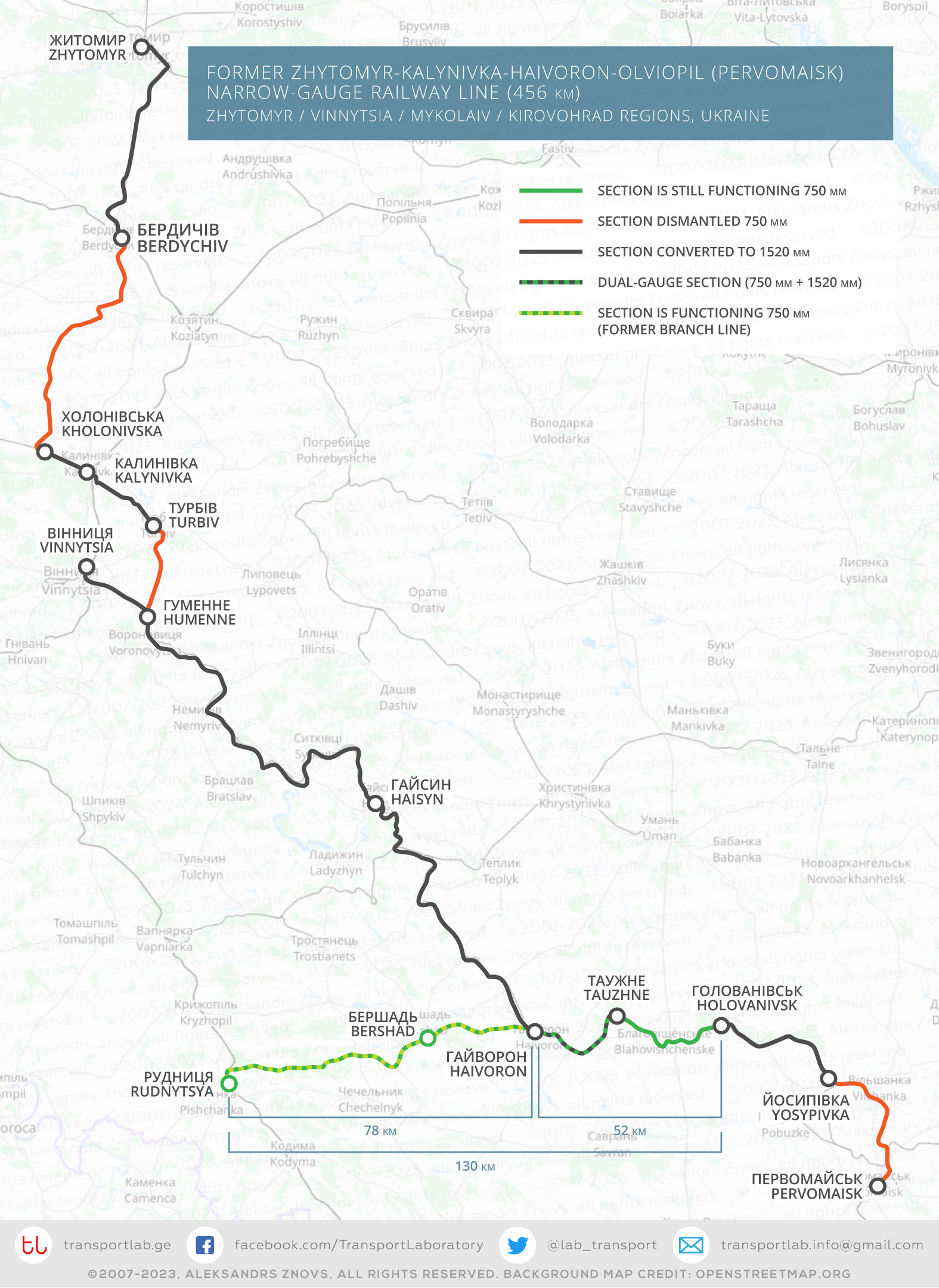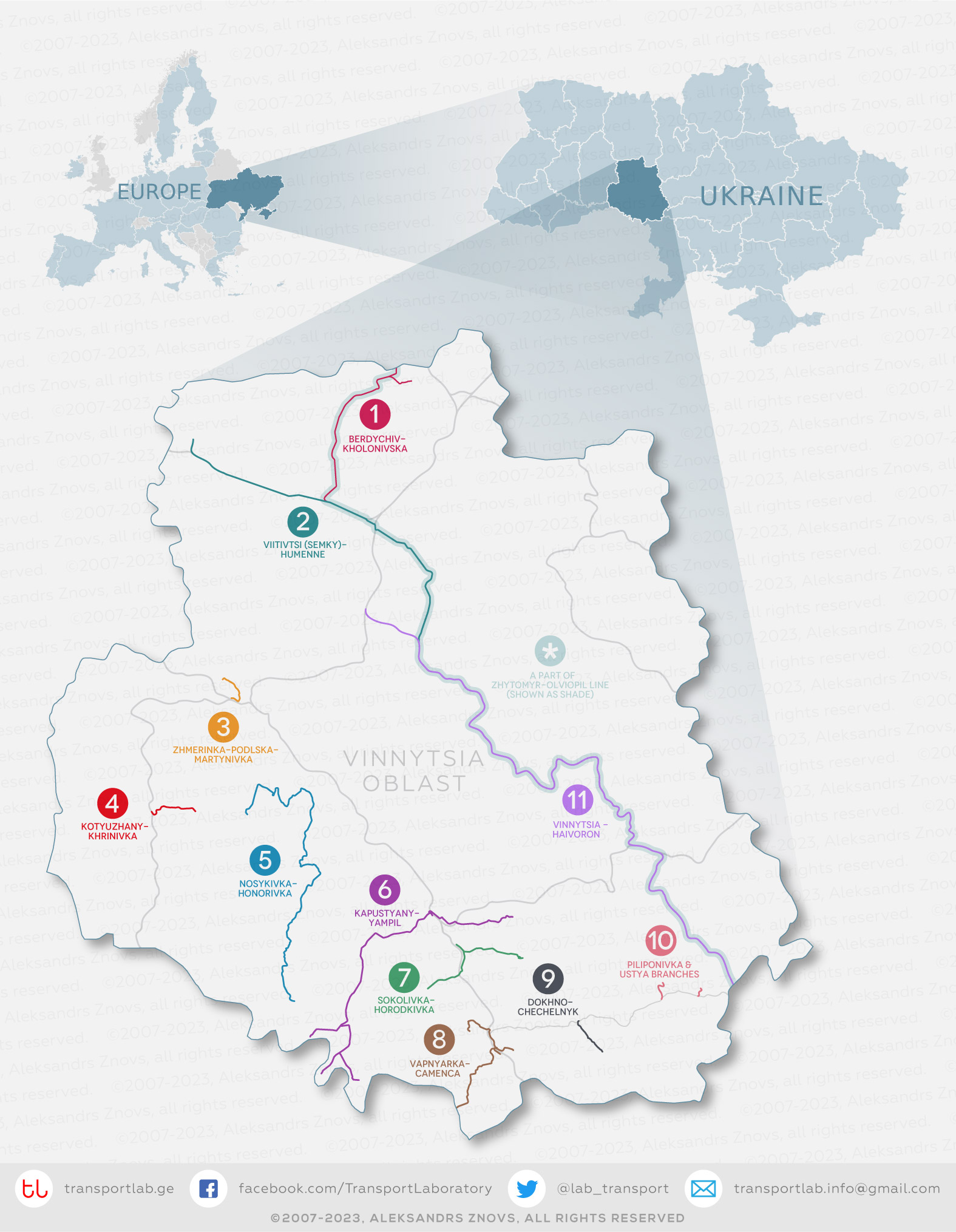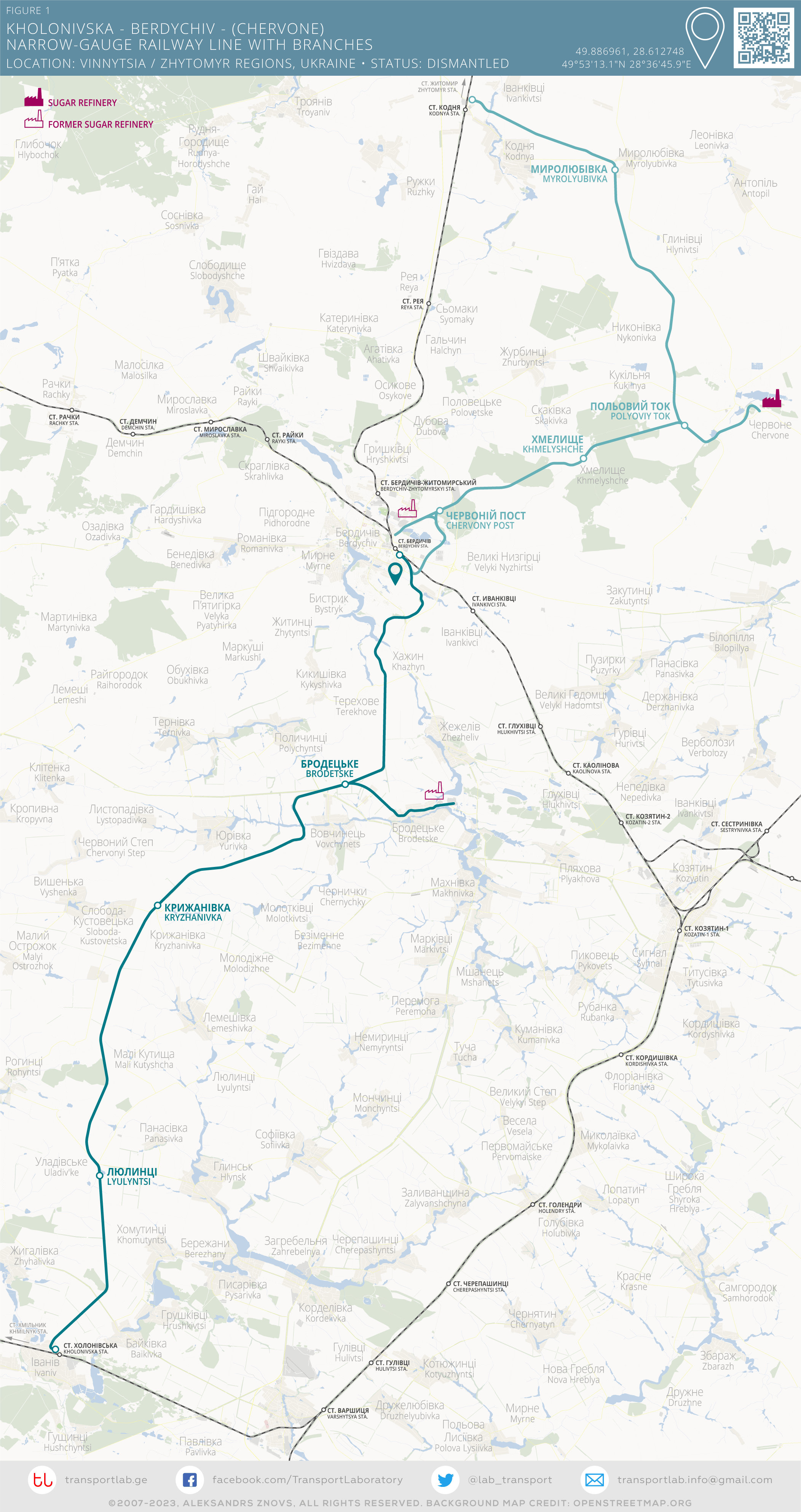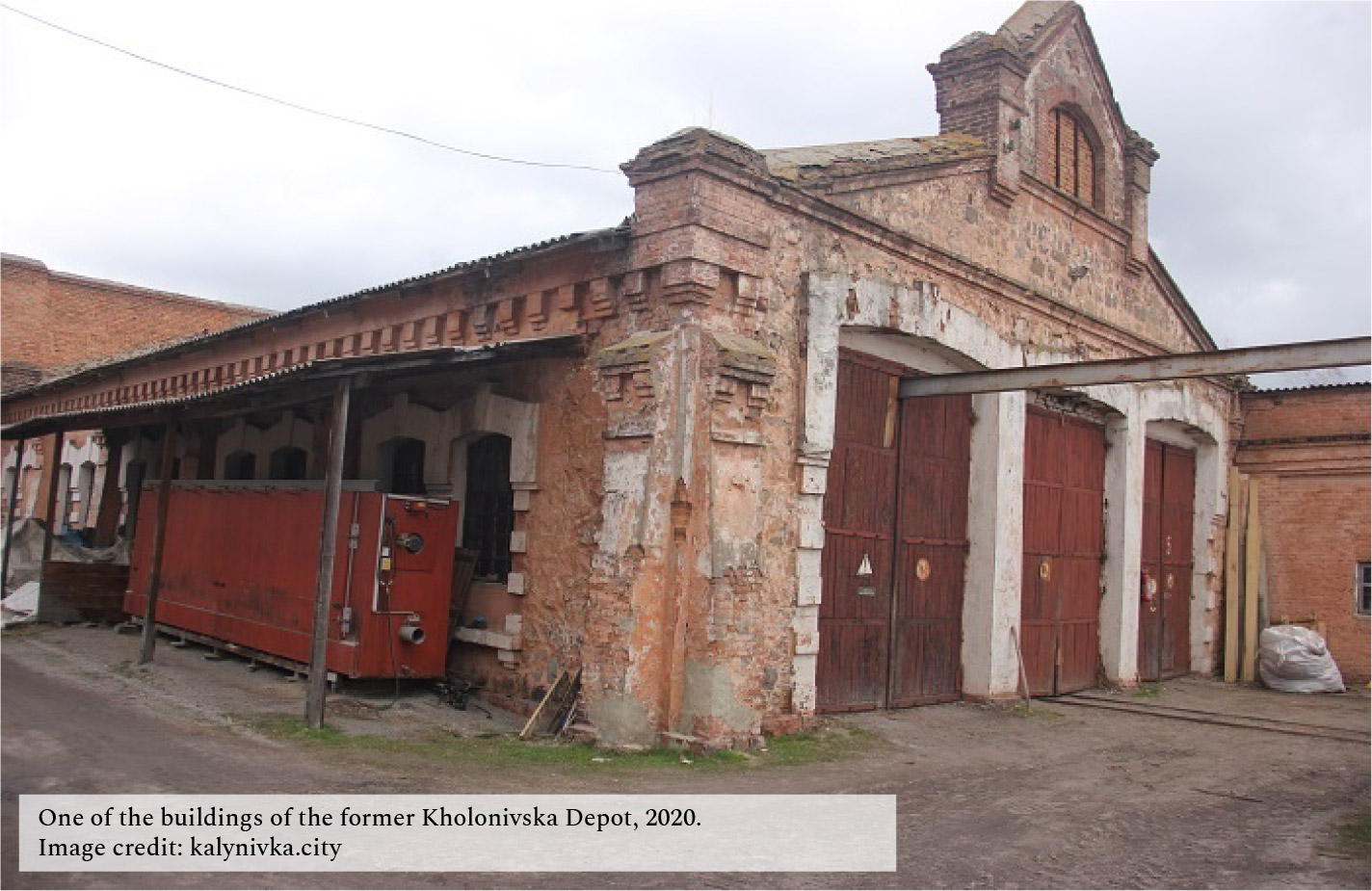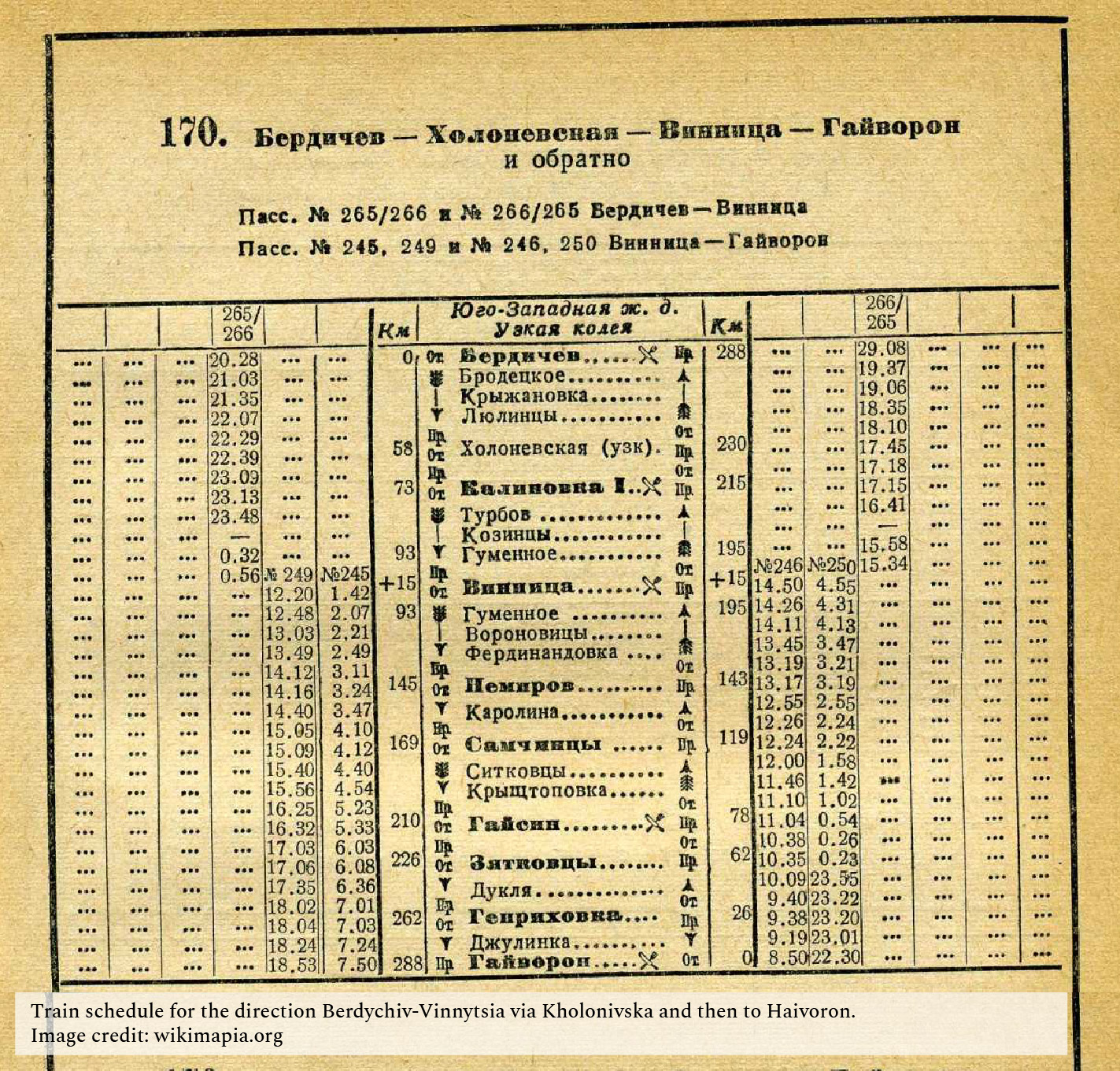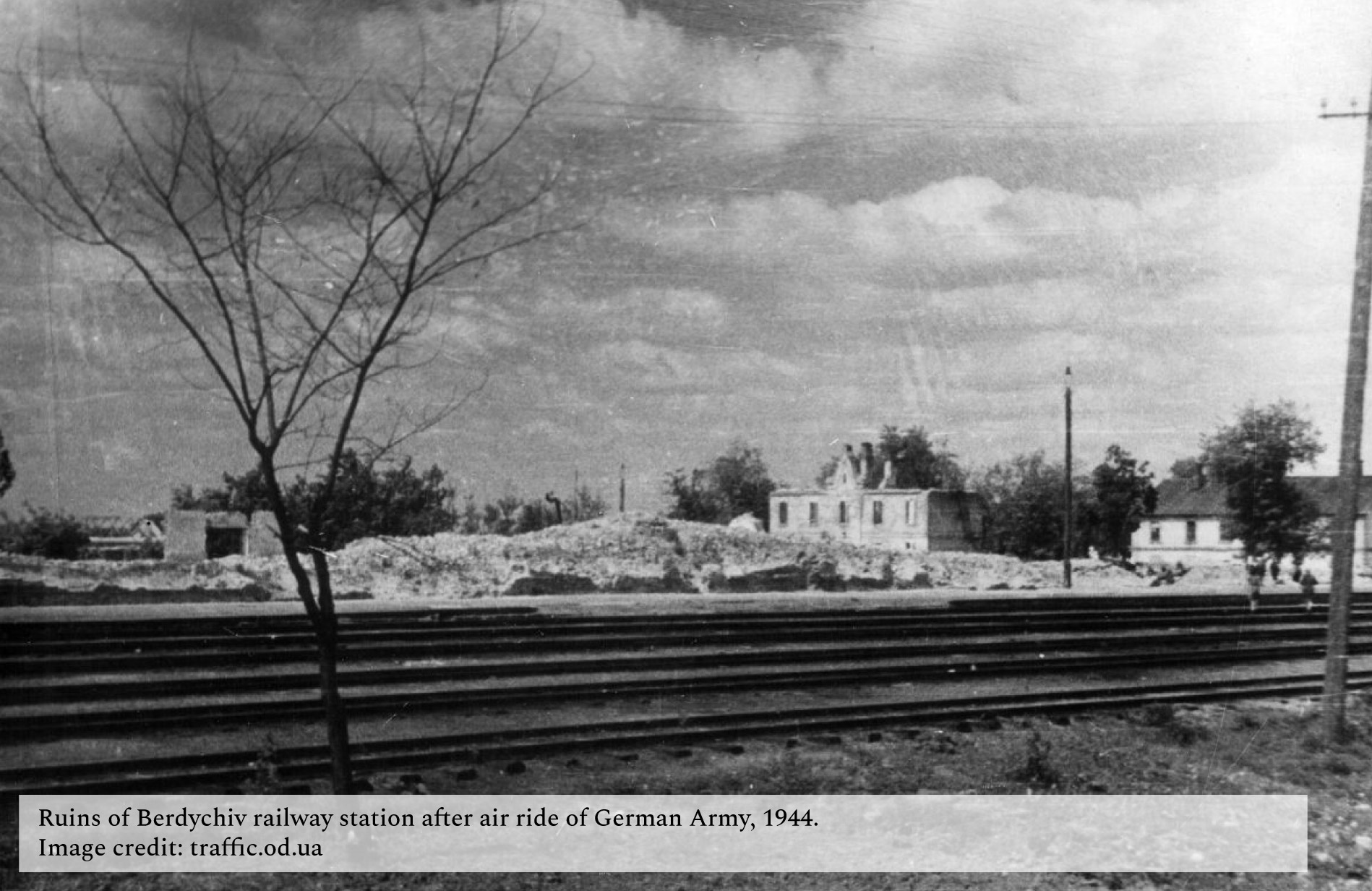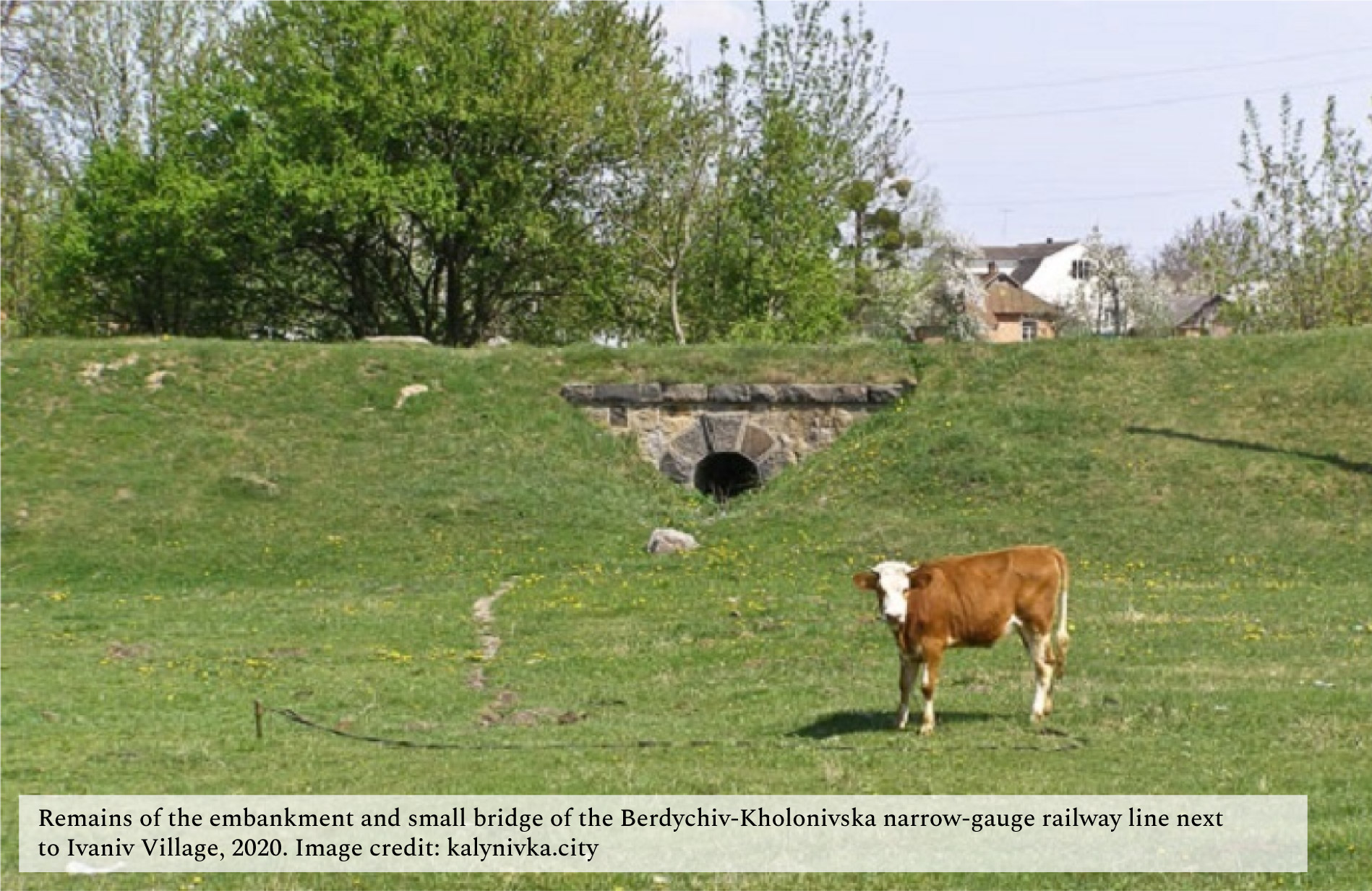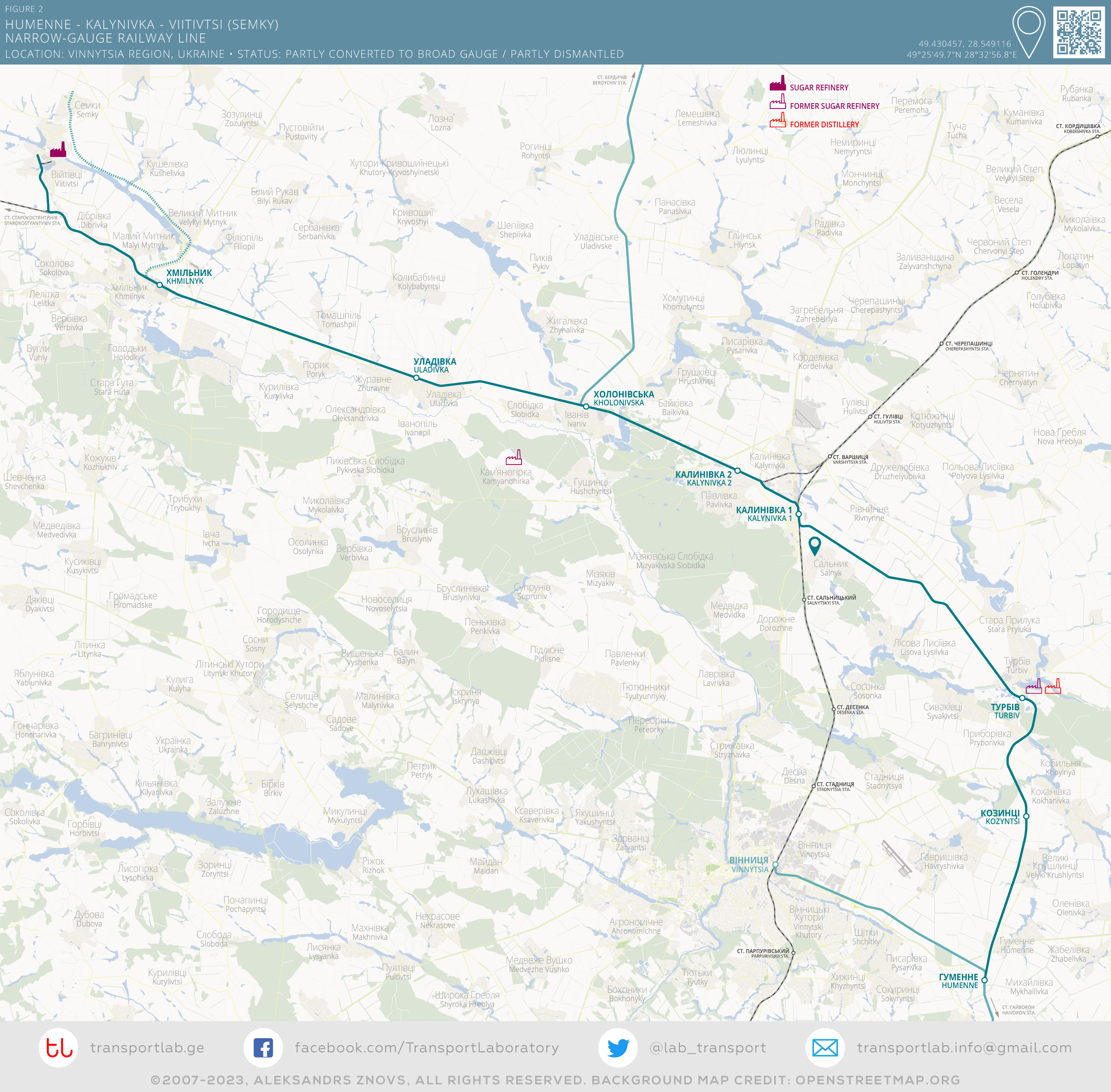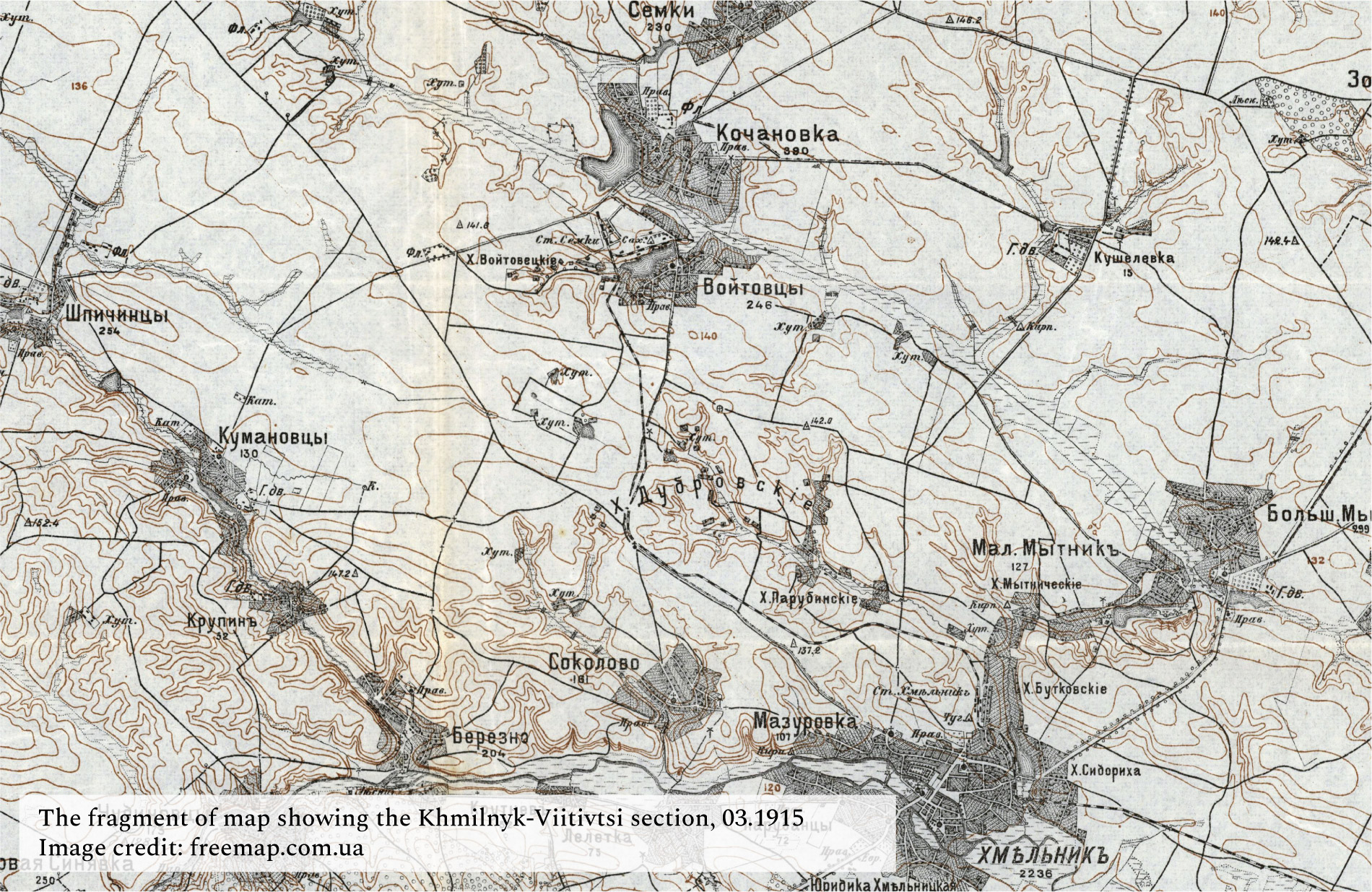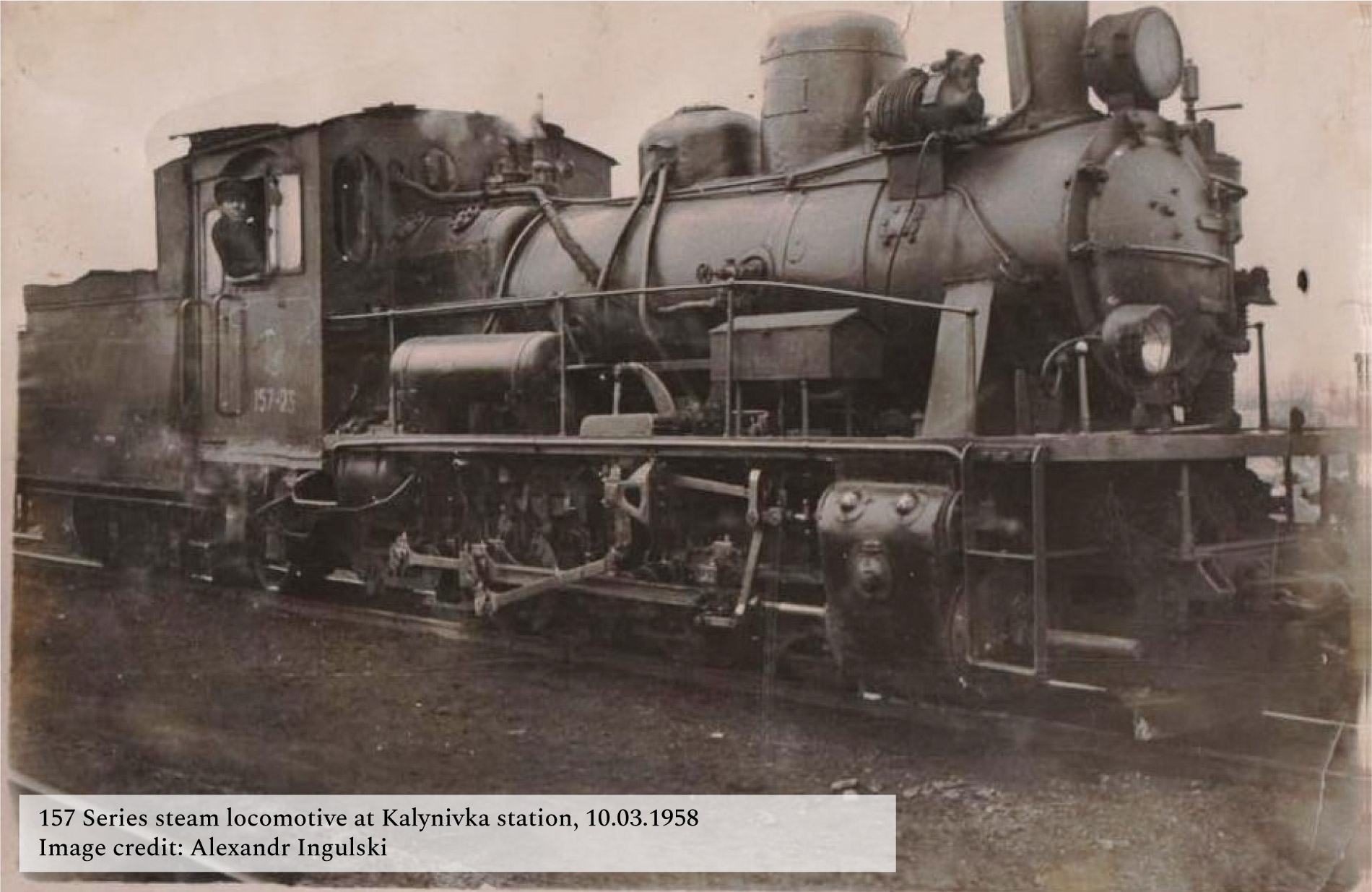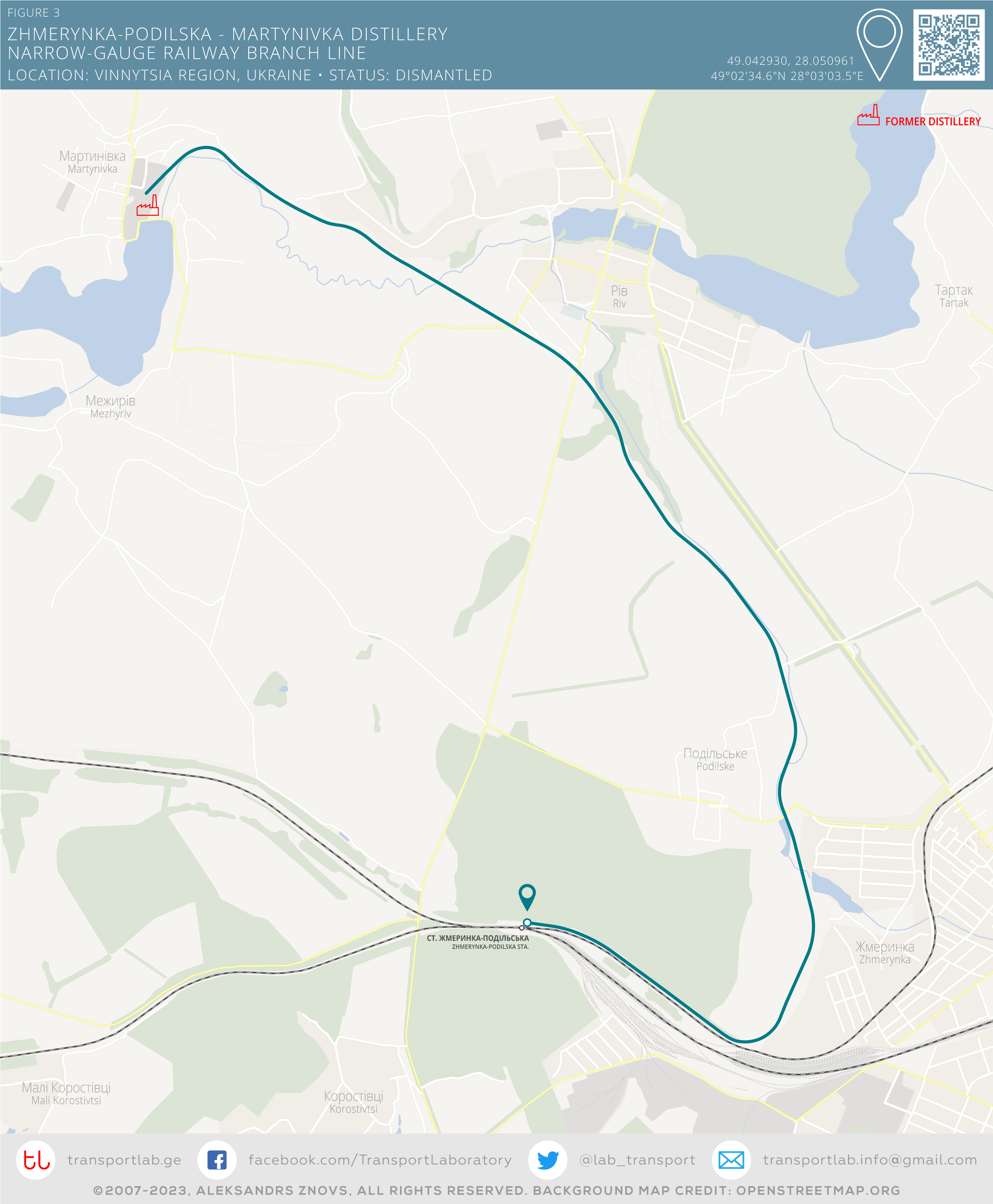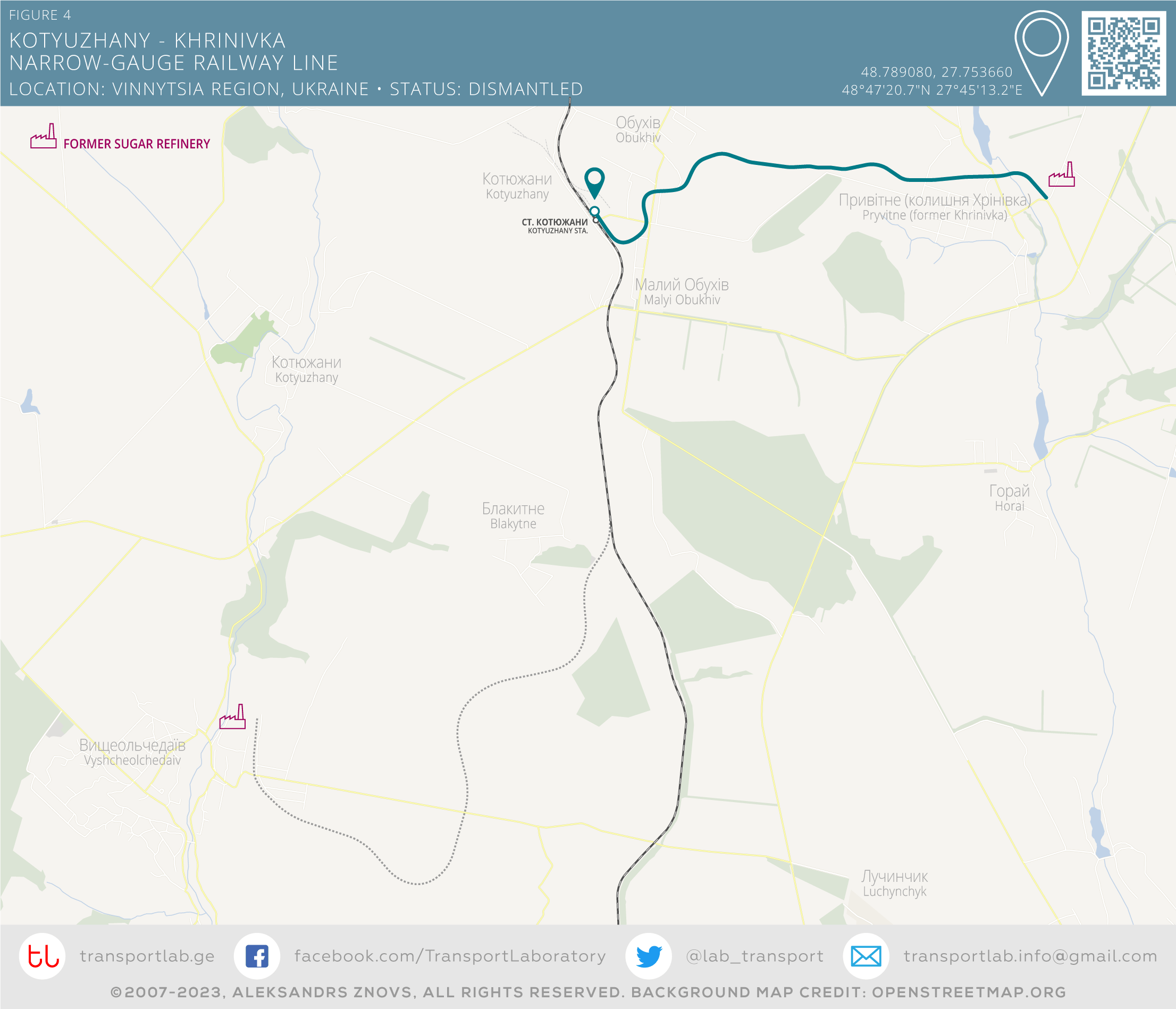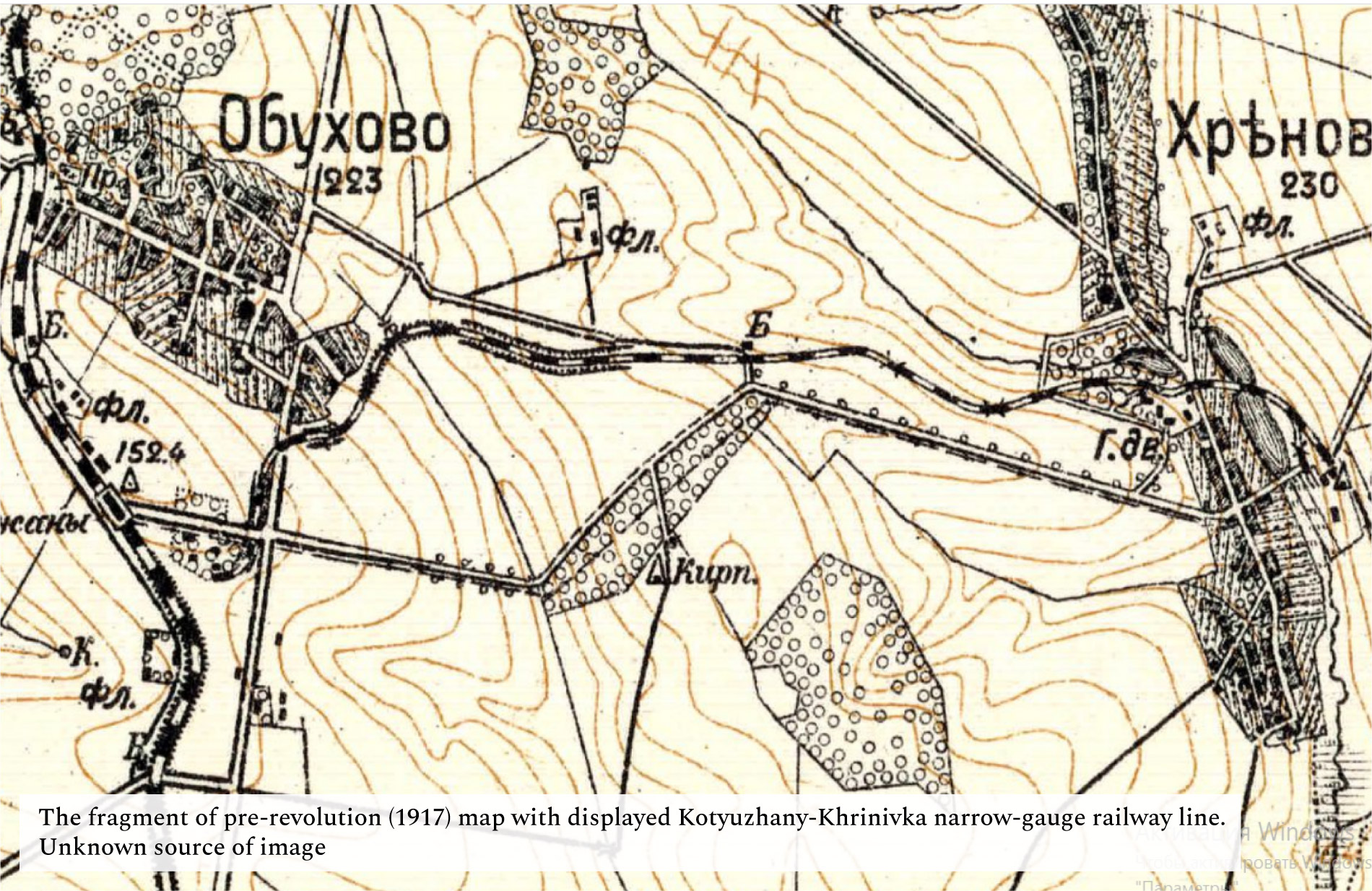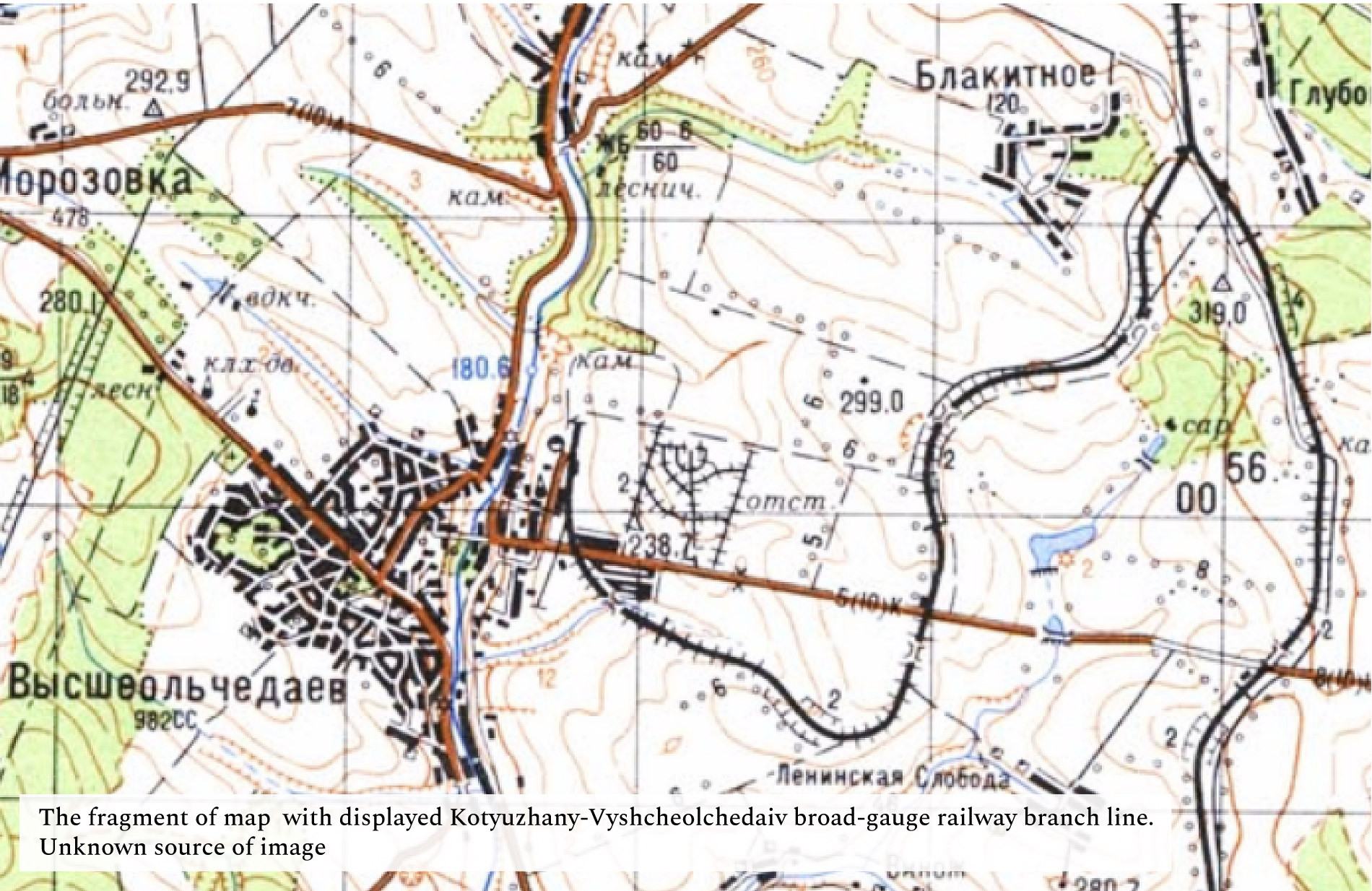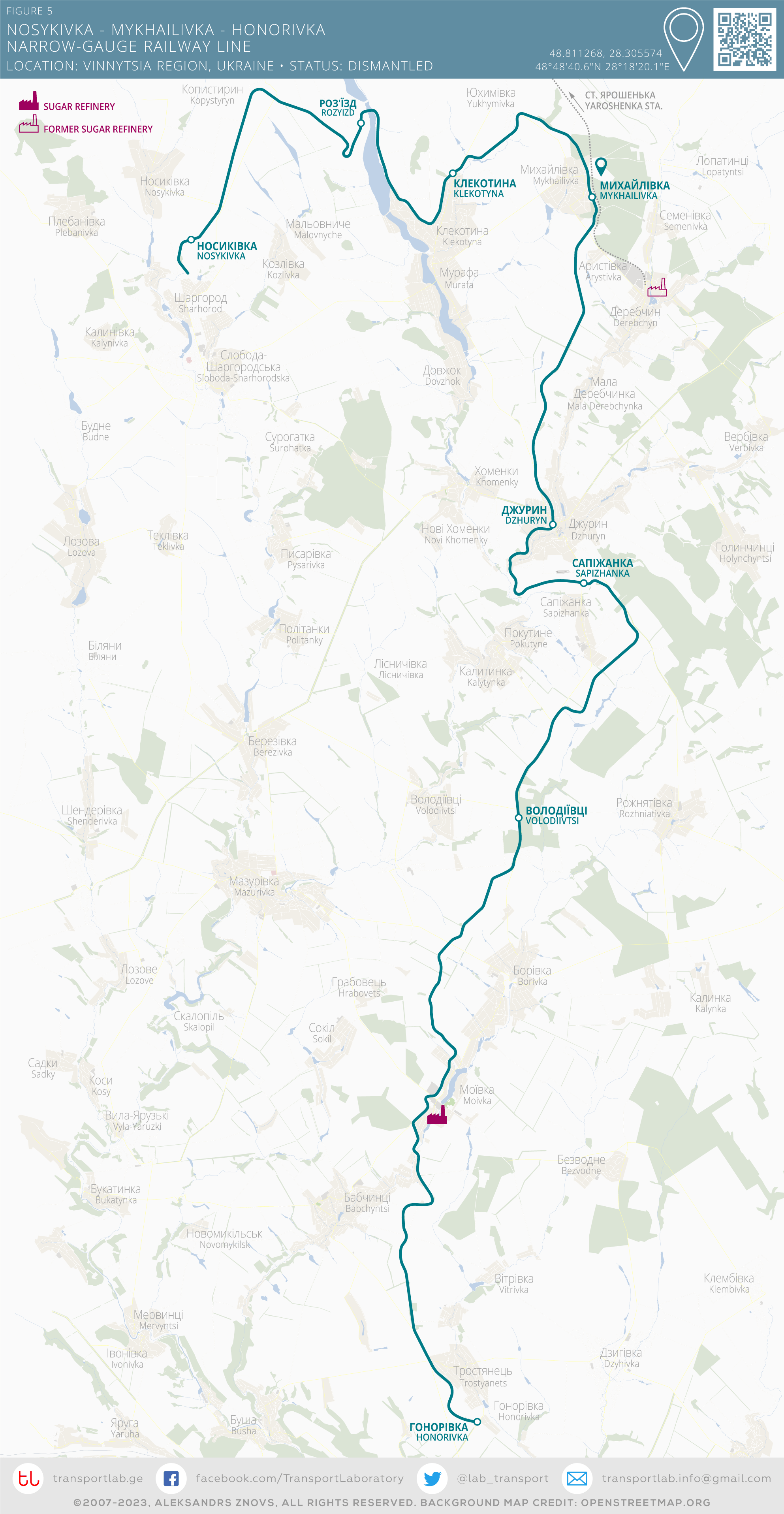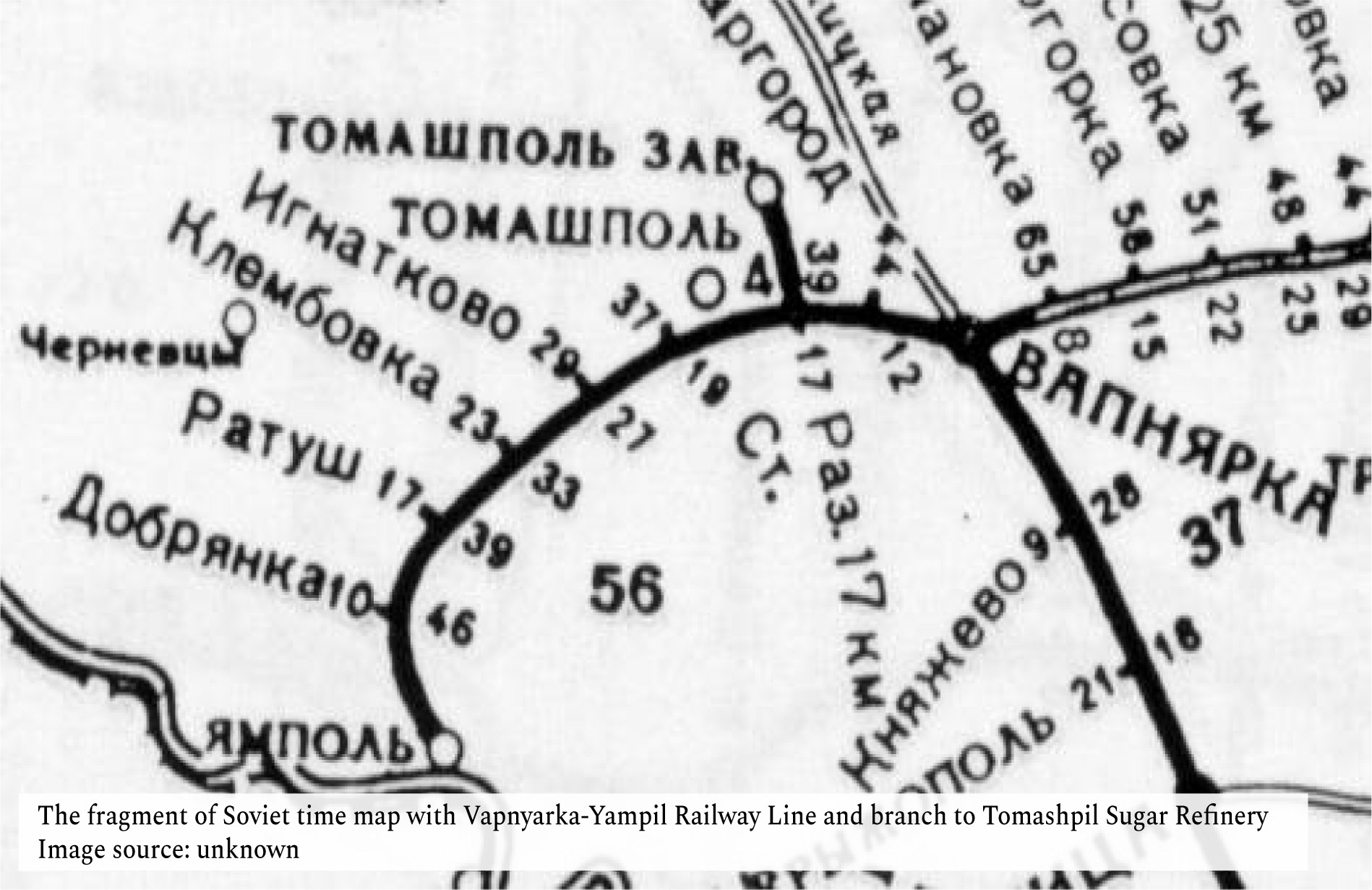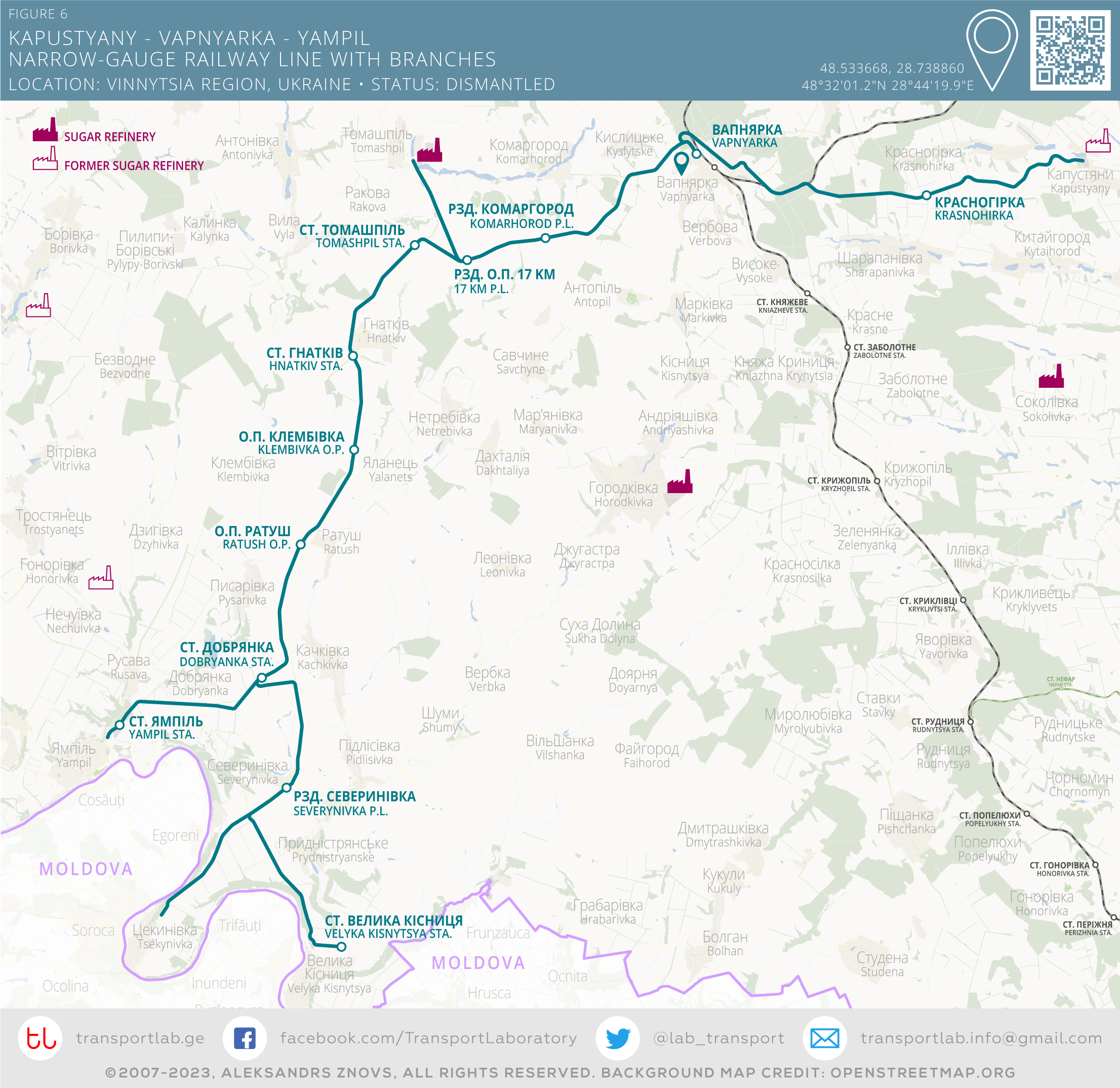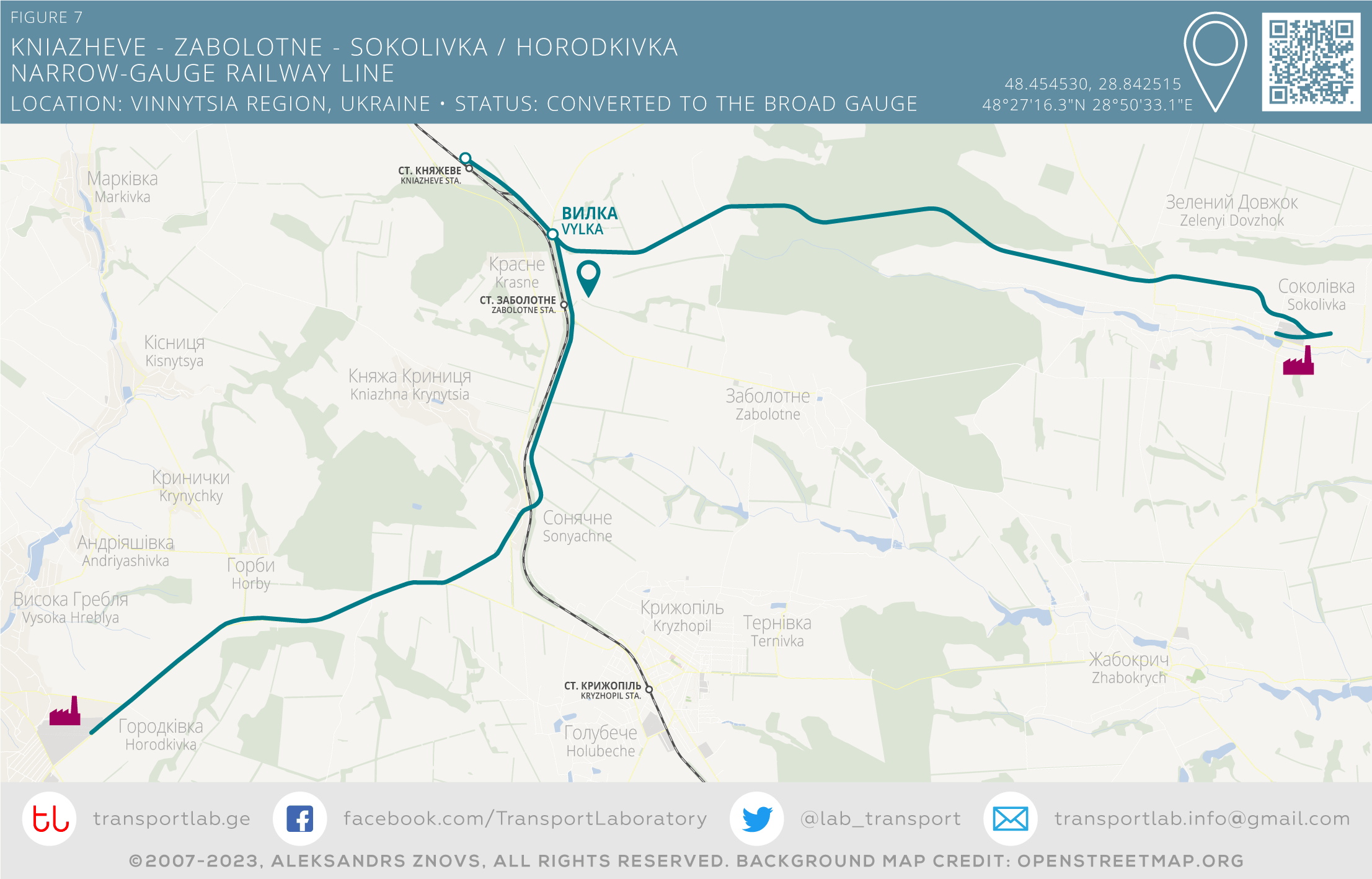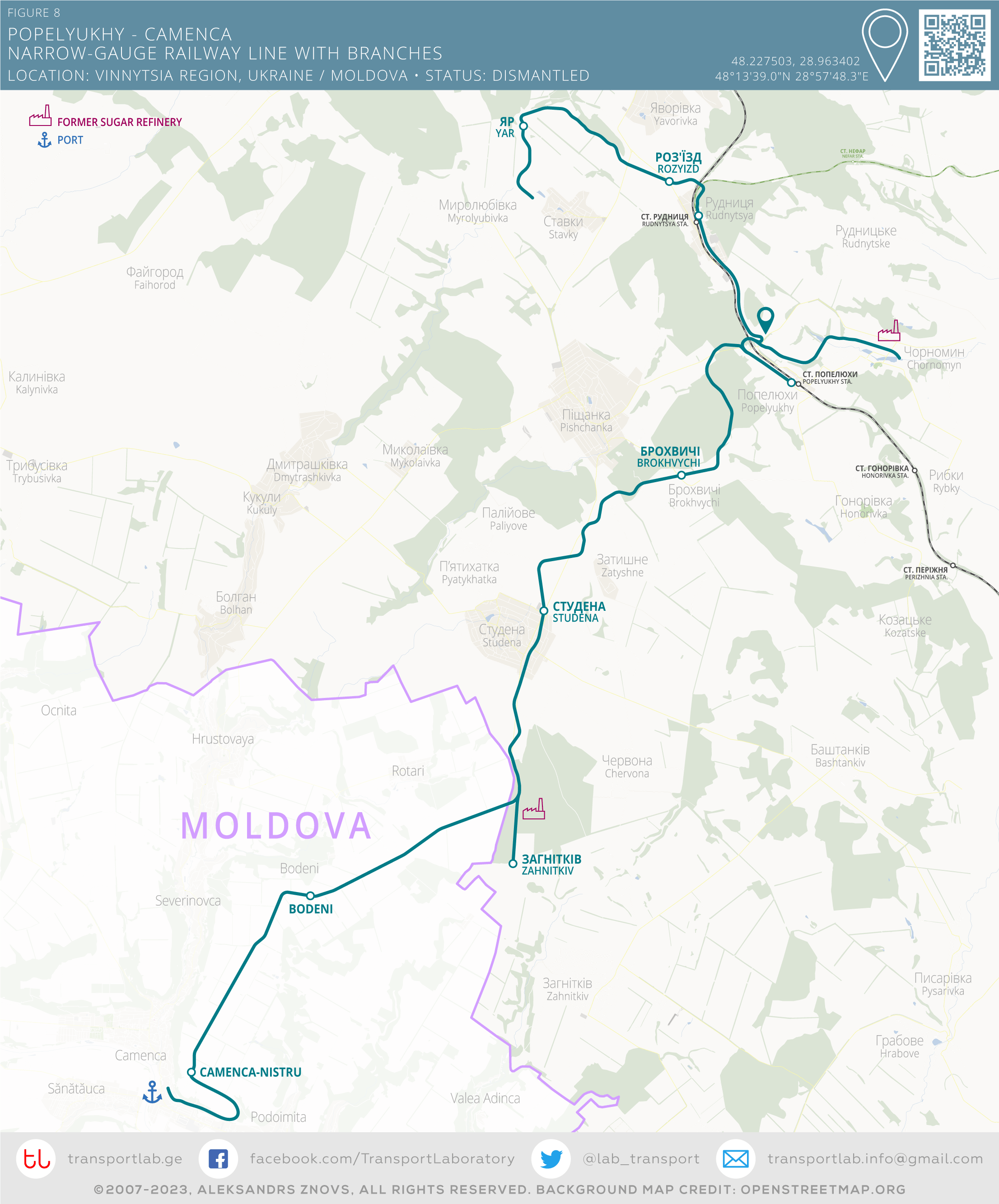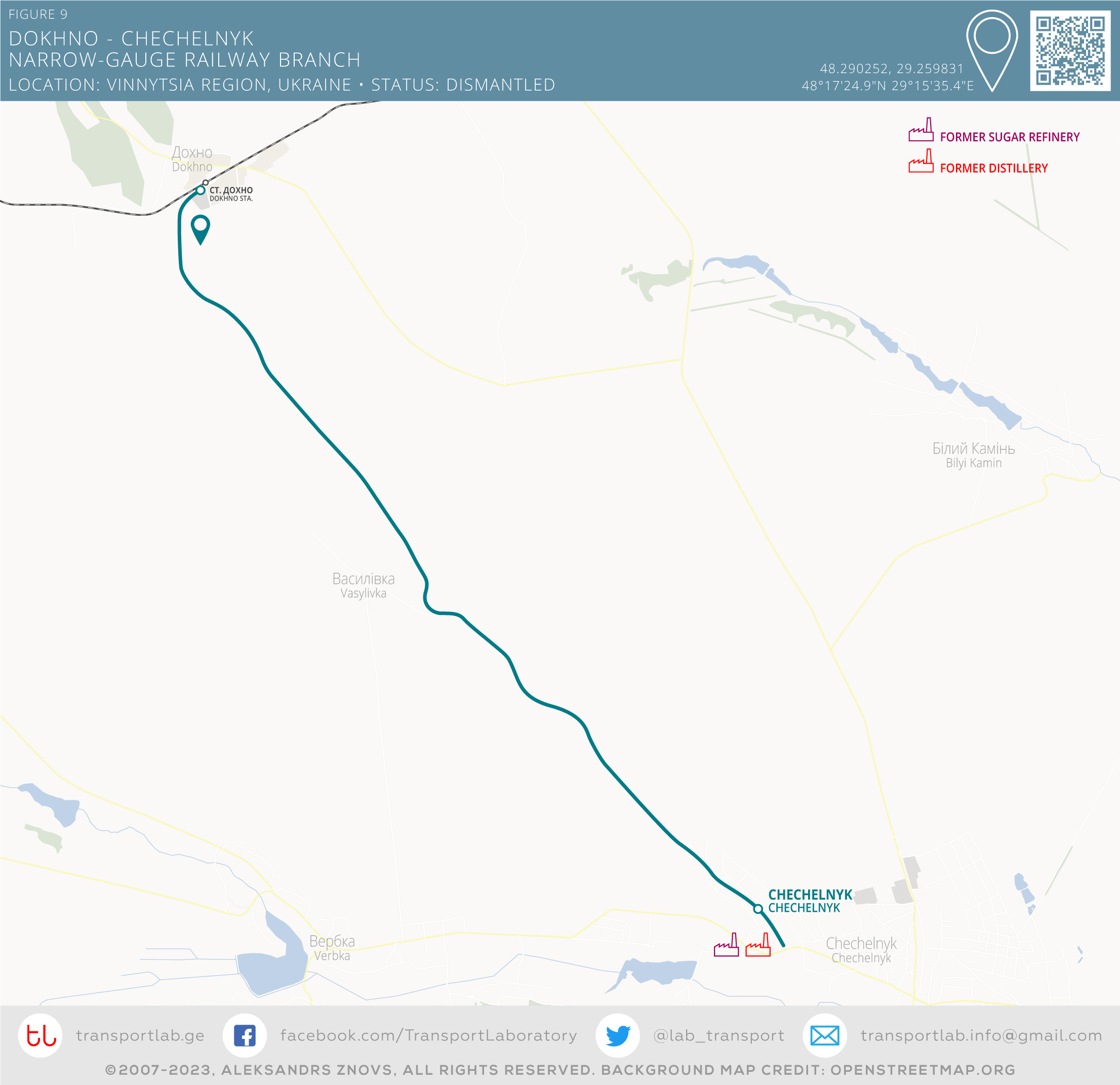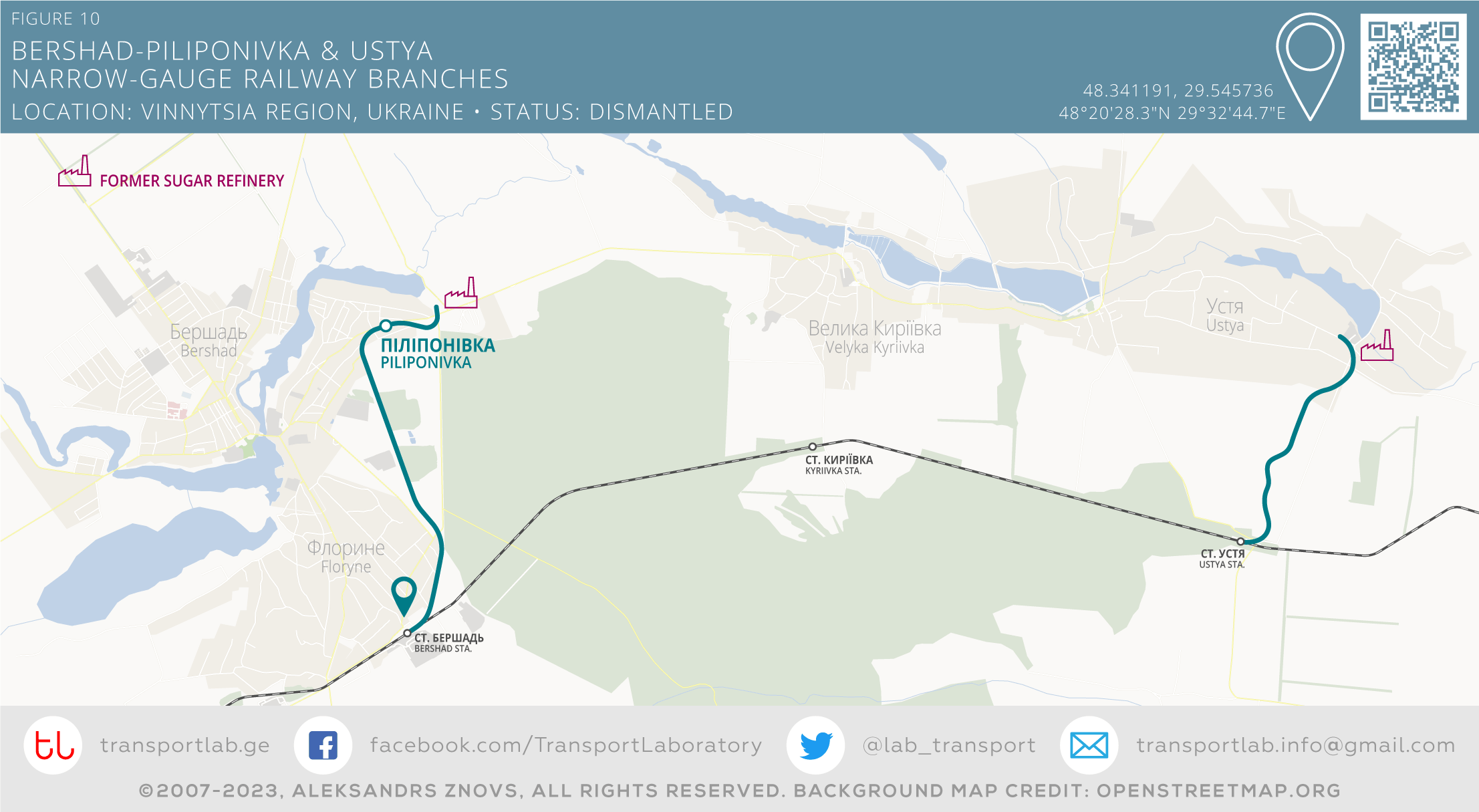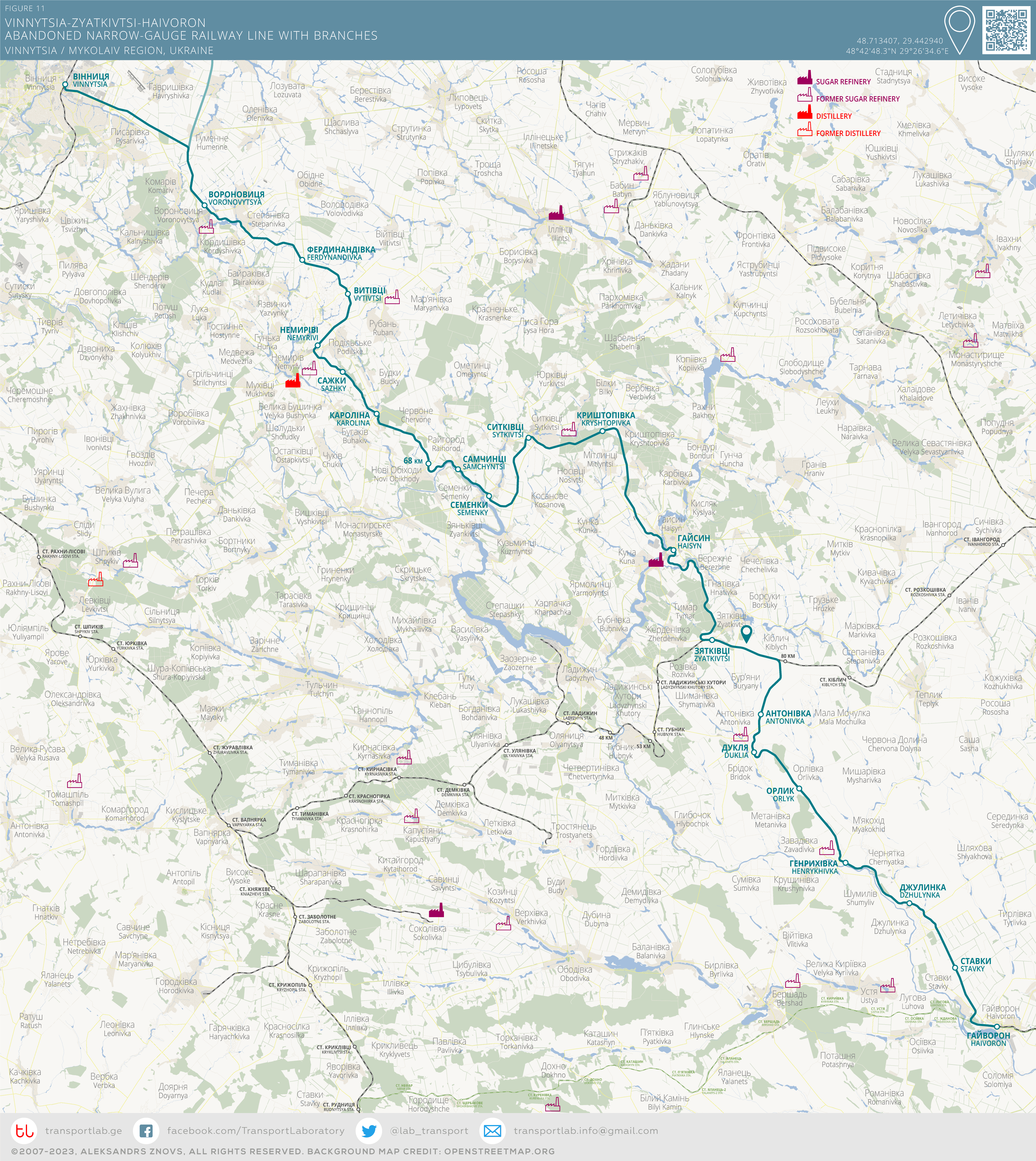Where and when it all began
The construction of any railroad usually is not limited by administrative boundaries. Although in this article we are focusing on the Vinnytsia Region, we must see the whole picture. Let’s start with this: at the end of the 19th century, when Ukraine was still a part of the russian empire, the headquarters of a joint-stock company named The Southern Society of Access Roads (Rus: Южное общество подъездных путей) decided to build a narrow-gauge railway in the western part of central Ukraine. So, in 1900, the 465 km long Zhytomyr-Olviopol narrow-gauge line was inaugurated. Its tracks passed through the Berdychiv, Kholonivska, Kalynivka, Turbiv, Humenne, Haisyn, Zyatkivtsi, Haivoron, Pidhorodna and terminated at Olviopol (nowadays: Pervomaisk).
Click on the image below, then right-click to open the full resolution image which you can zoom in for online preview or download to your device.
Nowadays, this line, which crosses the borders of as many as four regions of Ukraine, consists of a small 52 km long still operating narrow-gauge segment from Haivoron to Holovanivsk plus the 78 km long Rudnytsya-Haivoron section, which was a branch line, but now is an extension of the abovementioned mainline segment. So Ukraine still can be proud of the longest European narrow-gauge railway line (750 mm) with a length of 130 km, which is still in operation. Of course, the mentioned joint-stock company had some other projects, for example, the Kyiv-Zhmerynka-Odesa Line, which also crossed the territory of the present Vinnytsia Region (“oblast” in Ukrainian), nevertheless, we will focus on the Zhytomyr-Olviopil Line and other smaller lines that were once present locally.
For your convenience, I decided to divide the information into several parts – each part for a vanished branch or some parts of the once-existing Zhytomyr-Olviopil main line. Each branch has its own story and interesting details. It was also possible to find some images associated with the history of each “piece of the track”. The information is quite scarce, but I will share everything that I managed to find. I will not place much emphasis on the functioning Haivoron Narrow-Gauge Railway, since it would be a real off-topic – here we will read about what we have lost. Additionally, on the maps below I decided to add the icons of sugar refineries and distilleries, because this region was and still is a leader of sugar production and most narrow gauge lines even has been built for this purpose. Okay, let’s start with my visual “table of content” where you will easily locate each branch visually and will find the part of the article by number. Here we are:
1. Kholonivska-Berdychiv-Chervone Line
This narrow-gauge line actually was a part of opened at the beginning of 1900’s main line from Zhytomyr to Olviopil. This section had a short branch line from Brodetske Station to the village of the same name, where was a sugar factory. After the Berdychiv the line continued its way to Zhytomyr, as well as it also served a local sugar refinery right on the outskirts of the town of Berdychiv. Sometimes the segment between Zhytomyr and Berdychiv referred as “Zhytomyr Access Road” (Ukr/Rus: Житомирський під’їзний шлях / Житомирский подъездной путь).
In 1907, at the village of Chervone was opened one more sugar factory. Later it was connected with Berdychiv by an additional narrow-gauge branch line. Besides, there was also a seasonal narrow-gauge railway service from Chervone to the Kodnya. To deliver some liquid semi-raw materials (such as sugar syrup or molasses), this railway line used its rolling stock of tanks serving Chervone and Berdychiv sugar refineries. As we can see, the purpose of its construction was mainly to transport raw materials for sugar refineries, same as for many other narrow-gauge lines in the region.
In 1936, after the Khmilnyk-Kalynivka section (you can read about it below) was converted to a broad gauge, a narrow gauge tracks from Berdychiv aproached the Kholonivska Station building from one side, but the broad gauge was on the other side. By the way, one of the three locomotive depots of the entire narrow-gauge network in the Vinnytsia Region was at Kholonivska Station. The building has survived to this day.
There were also daily return passenger trains serving the Berdychiv-Kholonivska-Vinnytia section. They took their travellers to the end station in 4-4,5 hours.
Referring to the presence of a parallel broad-gauge line Kozyatyn-Kalynivka, the authorities decided to remove the track infrastructure between Berdychiv Station and local sugar refinery but later the entire line to Kholonivska. Tracks were completely dismantled during 1965-1970.
In the 80’s, the Berdychiv-Chervone section also has undergone its process of dismantling. Finally, in 2001 there were nothing to remain. By 2003 the Chervone-Kodnya section suffered the same fate. Sugar factories in Berdychiv and Brodetske ceased to exist, and only a refinery in the village of Chervone is still operating. The Zhytomyr Access Line was a narrow-gauge standard until 1915, after which it was converted to a broad gauge standard. The historical railway station building in Berdychiv has not been preserved, since it was blown-down during the air ride of German air forces in 1944. The building was replaced by a typical one built according to the “best” traditions of soviet architecture – the same buildings can be seen in some other cities of Ukraine.
Finally, all that remains from the former glory of the former Berdychiv-Kholonivska line, such as embankments and some small bridges over the streams and tiny rivers for good and all are overgrown by bushes and trees.
2. Humenne-Kalynivka-Viitivtsi (Semky) Line
At the end of the 19th century, as a part of the Zhytomyr-Olviopol Line, the narrow-gauge segment from Kalynivka to Kholonivska was constructed. In the same year, the extension to Khmilnyk took into service, and Khmilnyk Station opened its doors to passengers. Slightly after it, the line was extended to the Viitivtsi Sugar Refinery. As per some sources and maps the line had slightly different path (shown as dashed line on the map below), but no proof can be found. Tracks reached also the village of Semky. The line saw passenger and freight traffic, focusing on servicing sugar refineries, distilleries and coal supply.
n 1936-44, parallelly to the existing narrow-gauge line from Kholonivska to Khmilnyk, new broad-gauge tracks were built till the Starokostyantyniv Town on the westbound direction. The dismantling process of narrow-gauge tracks of this section began right after 1943 and in the 1950s all works were completed. Between 1965 and 1970 the narrow-gauge section of Turbiv-Kalynivka was converted to a broad gauge. At the same time, all narrow-gauge tracks of the Turbiv-Humenne section were completely dismantled without any plan of conversion.
3. Zhmerynka-Podіlska – Martynivka Distillery
Built in 1872, Martynivka Distillery was considered the largest in the district. There was also a narrow-gauge railway branch with the length of 7 km from the Zhmerynka-Podilska Station. It already existed in 1928, but there is no information when it built. The line completely dismantled within 1986. People talk about the unique level crossing of the narrow and broad gauges at Zhmerynka-Podilska Station: the level of narrow gauge tracks was approximately 20 cm higher than the broad ones. When a narrow-gauge train approached, a three-meter removable metal “bridge” has been mounted over the the broad-gauge tracks to get on the other side.
4. Kotyuzhany-Khrinivka Line
In the 1890s, a 6,5 km long narrow-gauge railway line from Kotyuzhany Station to the village of Hrinivka (now Pryvitne) to supply the sugar refinery with raw materials such as sugar beets and to deliver the refined sugar back to the Kotyuzhany Station for further transportation. As known, the line existed even after the Second World War, but there is no information about when it was dismantled.
By the way, same distance from Kotyuzhany Station, in the village of Vyshcheolchedaiv was another sugar refinery. I supposed there can be one more narrow gauge railway line led to it, but then it turned out that these were broad-gauge tracks. In the web I found some scans of old maps of the area of both abovementioned railway lines. Let’s take a look on them:
5. Nosykivka-Mykhailivka-Honorivka Line
The 100 km long Nosykivka-Honorivka Line belonged to the Ministry of Food Industry of the USSR and opened in 1933. The line mainly served sugar refineries and was connected to the Zhmerynka-Vapnyarka broad-gauge main line by a broad-gauge branch between Mykhailivka and Yaroshenka Station. The line had its rolling stock consisting of 2 steam locomotives and 10 diesel locomotives of the following types: TU2, TU7, TU7A, and TU8 – 12 items in total. The line was closed in 1999, sold to a private company in 2001, but then completely dismantled.
6. Kapustyany-Vapnyarka-Yampil Line
Primarily the line was planned in 1908 as a Vapnyarka-Zherbieny Line to serve military demands of russian empire. The first 23 km long section of the line from Vapnyarka to Kapustyany Sugar Refinery was built between 1901 and 1910. This segment used for cargo traffic only, primarily to provide the refinery with raw materials. The construction of the remaining part of the line from Vapnyarka to Yampil (56 km), including the branches of Dobryanka-Tsekynivka (18,5 km) and Severynivka-Velyka Kisnytsya (10 km), was completed in 1941. There was also plans to build a parallel broad-gauge line to Yampil with an extension to Gyrbova and Ocnita in Moldova. The passenger service between Vapnyarka and Yampil consisted of one-car train, which travelled the 56 km long distance in a few hours – it fully served the entire passenger flow.
The section of the Vapnyarka-Kapustyany line began from the left side of the Vapnyarka Station. It passed the main Zhmerynka-Rudnytsya broad-gauge line through a tunnel north of the Vapnyarka Station, near the Kyslytske Village.
The branch line to Tomashpil Sugar Refinery was demounted in 1959, but the section between Severynivka and Velyka Kishytsya was dismantled before 1975. In the early 80s, the branch line to Kapustyany dismantled. The line to Yampil was disassembled relatively recently – in 1997-99. In the early 2000s, there was already no traces of this line except the empty depot building and water tower at Vapnyrka and railway embankments along the former line route. The wagons and locomotives were transferred to the Haivoron Depot and still in use on the last remaining Haivoron-Rudnytsya-Holovanivsk narrow-gauge line.
Rolling stock: Steam locomotives Gr-319, 320 (now both are in the Lavassaare Railway Museum, Estonia); Diesel locomotives TU2-007, 009, 095, 133, 135, 137, 262; TU7A-3079, 3100 (all transferred to the Haivoron Depot).
On the Internet, I came across several images of loading an old steam locomotive onto the wagon platform for its further transportation to Estonia and subsequent restoration for the exposition of the Museum Railway in Lavassaare. I think this footage is worth adding to this article:
7. Kniazheve-Zabolotne-Sokolivka/Horodkivka Line
A 40 km long railway line, mostly served sugar refineries in Horodkivka and Sokolivka, and at the Kniazheve station there was reloading of goods into broad gauge wagons. The information when line was built still cannot be found. The line was converted to the broad gauge in 1984-1985. At the Horodkivka trains passed over the broad-gauge main line by bridge which remains is still present. After the conversion to the broad gauge new bridge was built nearby old one. Both sugar refineries are still working, same as the fork-like line serving all needs of facilities.
8. Popelyukhy-Camenca Line
In the 1930s, as a part of the narrow-gauge railway network development, a branch line from the Rudnytsya to Popelyukhy was built. New narrow-gauge tracks ran right along the broad-gauge tracks. Later this branch line was extended for 5 km till the sugar refinery (built in 1859) in the Chernomyn Village. In 1960s a 25 km long line was built from Popelyukhy Station in the direction of Zahnitkiv Village to serve military units located on the outskirts of the village. In 1939 the line was extended for another 17 km to the Camenca Village (now Camenca-Nistru, Republic of Moldova) on the banks of the Dniester River, thus providing the access to the port facilities. I still didn’t find more information according to the former Rudnytsya-Stavky branch line, if any will be find the updates will be added.
In the late 1980s, there were plans to convert the Popelyukhy-Camenca section to a broad gauge but the collapse of the Soviet Union put all these plans on pause. The line has not been in operation since 1997 and was dismantled in 1999.
9. Dokhno-Chechelnyk Line
In 1900 was opened traffic on all sections from Berdychiv to Haivoron. In 1901 opened also a branch line from Dokhno Station to Chechelnyk, where was sugar refinery. In 1995 all operations were ceased, but in December 2003 all tracks were dismantled completely.
10. Bershad-Piliponivka & Ustya Branch Lines
The Bershad Sugar Refinery was built in 1827. The railway line that served this plant was most likely built in the coming years after the opening of the Zhytomyr-Olviopol main line in 1900. The tracks were dismantled in 1991, and the plant itself ceased to exist in 2003. Not much is known about the sugar refinery built in 1886 in the village of Ustya and its railway access line, but the line was built in 1943, but dismantled probably in 1960-70s.
11. Vinnytsia-Zyatkivtsi-Haivoron Line
The Vinnytsia-Zyatkivtsi-Haivoron Line was put into operation in 1900. It was a segment of the abovementioned Zhytomyr-Olviopil Line. As mentioned in some sources, in 1946 was built the branch line between Haisyn and Krasnopilka, but to date it wasn’t confirmed. In the 1960s, the conversion of narrow gauge to broad gauge began, and by 1975 the segment from Vinnytsia to Duklya was already broad-gauged. In 1976, it reached the Dzhulynka Station. According to information, in 1963 two daily return trains served passengers between Vinnytsia and Haivoron. The one-way trip took 6,5 hours.
Further, in the eastbound direction from Haivoron Station to Holovanivsk, there is a dual-standard railway track. Eastbound from the Gayvoron, the narrow-gauge railway goes to the junction station Rudnytsya, thus till Holovanivsk it forming a 130-kilometre long narrow-gauge line which still survived.
Afterwords
Even before the aggression of nazi russia against independent Ukraine started, the fate of this small piece of the once grandiose network was unclear. But knowing that after the war a long and difficult period of restoration of the country will begin, but in such situations, the preservation of such technical facilities as a narrow gauge railway, unfortunately, is not a priority. We can hope for some kind of miracle, although miracles, as we know, do not happen. Wishing all my best for beautiful Ukraine, its unbelievably brave folk and soon end of the war.
Special Thanks
First of all, I would like to express my gratitude to the YouTube channel Iron Highways (Залізні магістралі) and personally to Oleg Vasiliev (Олег Васильєв) for his amazing content, among which there were videos that forced me start writing this article. Many thanks to the local journalist from Vinnytsia Vlad Bodnar (Влад Боднар) for his direct assistance, Facebook group The Association for the Preservation of the History of Railways of Ukraine (Асоціація Збереження Історії Залізниць України), as well as to Alexander Ingulsky, Mihail Potupchik and everyone who shared, commented and adviced.
Sources of information used in the article:
vlasno.info
kalynivka.city
vajr.info
narrow.parovoz.com
33kanal.com
viitivtsi-gromada.gov.ua
m.day.kyiv.ua
real-vin.com
sg.vn.ua
traffic.od.ua
freemap.com.ua
sebram.livejournal.com
wikipedia.org
youtube.com
Title image credit: Andrus Roosma


